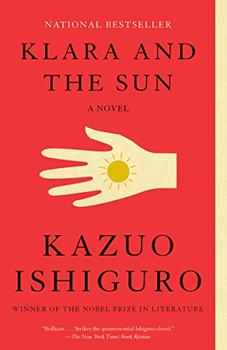Summary | Excerpt | Reading Guide | Discuss | Reviews | Beyond the Book | Read-Alikes | Genres & Themes | Author Bio

Critics' Opinion:
Readers' Opinion:
First Published:
Mar 2021, 320 pages
Paperback:
Mar 2022, 320 pages
 Book Reviewed by:
Book Reviewed by:
Elspeth Drayton
Buy This Book
This article relates to Klara and the Sun
 One of the central mysteries in Kazuo Ishiguro's novel Klara and the Sun surrounds the question of how some children are "lifted" and others are not. Seemingly benefiting from a class-based or other means-based differentiation, those who are lifted have access to higher-quality education and additional advantages. Precisely how some children are lifted is never entirely clear, though it is implied early on that medical or scientific intervention is involved, and some type of gene editing seems to be a likely explanation.
One of the central mysteries in Kazuo Ishiguro's novel Klara and the Sun surrounds the question of how some children are "lifted" and others are not. Seemingly benefiting from a class-based or other means-based differentiation, those who are lifted have access to higher-quality education and additional advantages. Precisely how some children are lifted is never entirely clear, though it is implied early on that medical or scientific intervention is involved, and some type of gene editing seems to be a likely explanation.
There are several forms of genome editing (gene editing) technology in the modern world that allow scientists to manipulate the DNA of various organisms. Perhaps the most scandalous use of such technology (and the one that bears the most relevance to the events of the novel) is referred to as the "CRISPR-baby" case. CRISPR-Cas9 is a genome editing technology that has been a reality in the scientific community for several years. In 2018, scientist He Jiankui claimed to have successfully used the CRISPR system to edit the genomes of two human embryos and implant them in a woman who brought them to term. The allegedly edited embryos appear to have generated healthy children known now as Lulu and Nana. He was attempting to recreate a certain genetic mutation in order to protect the embryos against HIV infection, but there are concerns that he may have caused other complications in the process. The outcomes of his experiment are as yet unproven and unknown. However, his actions caused international public attention and furor from the scientific world.
One reason why human gene editing is not common practice in the medical field is the unpredictable nature of the human genome. Which is to say, there are a high number of unknowns when it comes to the possible consequences of editing genes. This makes the entire pursuit technically and morally fraught, as test subjects may experience severely encumbered or otherwise challenging lives.
Editing the genome of embryos with the intention of implanting them to bring fetuses to full term is a form of gene editing that is generally disapproved of internationally, but the actual restrictions in place vary between countries and are sometimes ambiguous. Following He's experiments, for which he was sent to prison and fined, the Chinese government established additional restrictions on the practice of gene editing, and some have called for a worldwide moratorium on gene editing in human embryos.
However, instances of editing for the purpose of gene therapy, such as modifications for fighting disease not in embryos but in people, are not as controversial in the scientific world and have resulted in positive outcomes in clinical trials for some adults facing debilitating and chronic conditions. A one-year-old child in Britain with leukemia underwent gene therapy (not with CRISPR but another technology called TALENs), which saved her life, though this was a special case and was permitted only under a high degree of scrutiny.
For some, it comes down to the question of whether we should do something just because we (potentially) can. Should parents be able to alter the genes of their offspring? What are the far-reaching implications of such a practice? Presently, scientists and government bodies tend to err on the side of caution and continue to severely limit research and experimentation based in the editing of genomes in human embryos. However, with technology advancing rapidly and demand for innovative solutions to disease, it seems these questions cannot be avoided for much longer.
A visual representation of the gene-editing technology CRISPR-Cas9 by Ernesto del Aguila III, National Human Genome Research Institute, NIH
Filed under Medicine, Science and Tech
![]() This "beyond the book article" relates to Klara and the Sun. It originally ran in March 2021 and has been updated for the
March 2022 paperback edition.
Go to magazine.
This "beyond the book article" relates to Klara and the Sun. It originally ran in March 2021 and has been updated for the
March 2022 paperback edition.
Go to magazine.





The Flower Sisters
by Michelle Collins Anderson
From the new Fannie Flagg of the Ozarks, a richly-woven story of family, forgiveness, and reinvention.

The House on Biscayne Bay
by Chanel Cleeton
As death stalks a gothic mansion in Miami, the lives of two women intertwine as the past and present collide.

The Funeral Cryer by Wenyan Lu
Debut novelist Wenyan Lu brings us this witty yet profound story about one woman's midlife reawakening in contemporary rural China.
Your guide toexceptional books
BookBrowse seeks out and recommends the best in contemporary fiction and nonfiction—books that not only engage and entertain but also deepen our understanding of ourselves and the world around us.